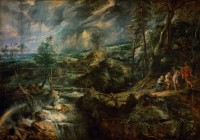 David with the Head of Goliath by Michelangelo Merisi da Caravaggio and Stormy Landscape with Jupiter, Mercury, Philemon and Baucis by Peter Paul Rubens, both in the Kunsthistorisches Museum in Vienna, are the latest recipients of a conservation grant from the Getty Foundation. They join the spectacular Ghent Altarpiece and Giorgio Vasari’s The Last Supper, brutalized in Florence’s great flood of 1966, as part of the Panel Paintings Initiative, a program that funds the conservation of damaged oil on wood panel masterpieces in order to train the panel painting conservators of tomorrow.
David with the Head of Goliath by Michelangelo Merisi da Caravaggio and Stormy Landscape with Jupiter, Mercury, Philemon and Baucis by Peter Paul Rubens, both in the Kunsthistorisches Museum in Vienna, are the latest recipients of a conservation grant from the Getty Foundation. They join the spectacular Ghent Altarpiece and Giorgio Vasari’s The Last Supper, brutalized in Florence’s great flood of 1966, as part of the Panel Paintings Initiative, a program that funds the conservation of damaged oil on wood panel masterpieces in order to train the panel painting conservators of tomorrow.
The €300,000 ($416,000) grant will be well-spent on dealing with the major issues plaguing both paintings. The Caravaggio depiction of the Biblical David holding his sword over his shoulder in one hand and the head of Goliath in the other, one of only two known surviving panel paintings by the Baroque genius, was savaged by past restorations that shaved the wood support to the thickness of a piece of paper. The plan is to remove the panels from the rigid wood cradle that is meant to keep them from warping and then, after they’ve had a chance to breathe a little and assume their natural positions, build a new cradle that is flexible and moves with the natural expansion and contraction of the wood. Conservators will also repair the panoply of fractures on the wood panels that you can see have already had an impact on the integrity of the paint.
The Rubens painting, which in a style typical of the Flemish Baroque adds figures from mythology or religion to a landscape, depicts Jupiter and Mercury leading their favored humans Philemon and Baucis away from a storm set to destroy their entire neighborhood. It’s a story told in Ovid’s Metamorphoses Book 8: 679-724 and while it wasn’t an unheard of subject for a painting, it wasn’t very popular and almost all of the previous treatments set the foursome inside Philemon and Baucis’ modest little cottage.
 This work is immense at 20.85 meters (68.4 feet) wide and 14.60 meters (just short of 48 feet) high [EDIT: I misread the dimensions. The painting is actually 2 meters by 1.46 meters. Thank you for the correction, Maurizio!]. Rubens made it all himself rather than enlisting the aid of his workshop painters, and did so without a commission. He used 10 pieces of wood joined together to make the vast panel and each plank has aged differently. The aging has left gaps between the 10 pieces that are clear to the naked eye.
This work is immense at 20.85 meters (68.4 feet) wide and 14.60 meters (just short of 48 feet) high [EDIT: I misread the dimensions. The painting is actually 2 meters by 1.46 meters. Thank you for the correction, Maurizio!]. Rubens made it all himself rather than enlisting the aid of his workshop painters, and did so without a commission. He used 10 pieces of wood joined together to make the vast panel and each plank has aged differently. The aging has left gaps between the 10 pieces that are clear to the naked eye.
The grant will not only enable the Kunsthistorisches Museum experts to work with some of the most accomplished and experienced panel painting conservators in the world on solving the thorny problems of the Caravaggio and Rubens masterpieces, but it will create a core of expertise that will expand in central and eastern Europe. Five conservators from Krakow, Dresden, Prague, and Vienna will be trained on these works. They will then be able to bring the invaluable expertise they learn on the job back to their homes. Two of the five are already teachers at conservation schools, so they’ll be able to immediately pay it forward to their lucky students.
Panel paintings are extremely complex to conserve because unlike artworks on canvas, they require an in-depth knowledge of carpentry as well as paint conservation in order to repair properly. It takes years to develop the necessary abilities and expertise, and there aren’t a lot of people in the pipeline. With the vast majority of current panel painting conservators approaching retirement age within the decade, in 2009 the Getty Foundation launched the Panel Paintings Initiative to bridge the alarming knowledge and experience gap.
With two more years of grant-giving to go and more years after that of continuing work, the PPI has already proven a brilliant success. More than 20 conservators have received in-depth training and years of practical experience working on some of the world’s greatest masterpieces on wood, and hundreds of other conservators and students have learned from workshops offered as part of the conservation projects, in university classes taught by people connected to the projects and from published studies.